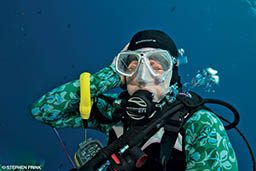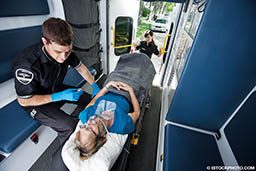My students asked what happens to the nitrogen bubbles in untreated decompression sickness (DCS). My guess was that they eventually get reabsorbed or offgassed via the lungs. What is the best answer?
Divers accumulate nitrogen (and/or other inert gases in their breathing mix) while diving. The deeper and longer the dive, the more gas accumulates. In cases of DCS, the inert gas load exceeds the tissues’ capacity, so bubbles form.
Gas enters the body through the lungs, moves into the circulatory system and then into other tissues. Offgassing occurs by the same mechanism in reverse: Inert gas moves from the body’s tissues into the bloodstream and then into the lungs, where it is exhaled. A diver offgasses when in shallow water after having been in deeper water (during ascent and while performing a decompression stop or safety stop, for example). Offgassing continues after the diver exits the water. The human body has no means by which to indefinitely retain gas or bubbles.
The vast majority of the inert gas is offgassed within a few hours, and almost all of it leaves recreational divers’ bodies within about 24 hours. This is why symptoms of DCS usually appear in the first hours following a dive and why onset of symptoms more than 24 hours after a dive generally does not represent DCS (except in special circumstances such as saturation diving or subsequent altitude exposure, for example).
Bubbles cause inflammation and local tissue injuries. The larger the bubble load, the more severe the injury and the faster the onset. Hyperbaric chamber treatment within the first 24 hours can eliminate gas and bubbles while the injury is still occurring. After about 24 hours, the injury has already occurred. Bubbles are no longer present, but the injury persists. Hyperbaric treatment after the first day can still be very helpful by promoting healing and recovery.
Although leaving DCS untreated is not recommended, its general progression is improvement over time. Some divers who do not get treated recover completely, but others have persistent problems that range from mild to severe.
For more information about inert gas, DCS and hyperbaric chamber treatment, visit DAN.org or call the DAN Medical Information Line at +1 (919) 684-2948.
— Frances Smith, MS, EMT-P, DMT
What is “oxygen ear”?

Also known as middle-ear oxygen absorption syndrome, oxygen ear describes a gas volume imbalance in the middle ear after diving with breathing gas that has a higher oxygen fraction than air. The phenomenon is commonly associated with open-circuit diving using nitrox and closed-circuit rebreather diving. The high-oxygen-content gas fills the middle-ear space over the course of the dive. Postdive, the tissues metabolize the oxygen, reducing the total gas volume below what it would be if the space were filled with air. If this loss in gas volume is not equalized, relative negative pressure will develop. This is in effect a squeeze, which can present as ear fullness, mild discomfort and/or impaired hearing.
This problem can be avoided easily with occasional equalization for several hours after diving. A person who is active, talking and/or laughing during this period may have no need to actively equalize. On the other hand, a person who goes to bed immediately after diving might wake up several hours later with mild discomfort. Full resolution is best achieved using gentle equalization techniques.
— Neal W. Pollock, Ph.D.
I’m 20 years old and will be having four wisdom teeth (third molars) removed soon. I understand I’ll have air pockets where my teeth were, and I assume those could cause problems while diving. How long should I stay out of the water?
Following an uncomplicated dental extraction, four to six weeks is normally sufficient time for the risk of infection to resolve. This assumes good healing and that gum tissue has filled in the empty sockets, eliminating any air pockets. An unhealed socket can be a route for infection as well as for air to enter subcutaneous tissues and cause further injury. Pain medication can impair your judgment underwater, so wait at least a couple of days after you finish taking it to resume diving.
Following the extraction of upper wisdom teeth, the dentist should verify that there is no sinus involvement. The root tip of a molar can breach the maxillary sinus floor, resulting in a communication (abnormal connection) between the mouth and the sinus. This is not common, but if it occurs it will further delay your return to diving. If there is sinus involvement, you should wait until the fistula (hole) is closed and healed before you resume diving. Your dentist or oral surgeon will be able to tell you how long this should take.
Discomfort, tenderness or delayed healing can make it difficult to hold a regulator mouthpiece, depending on the tooth or teeth involved and the length of the mouthpiece’s flanges. After your dentist or endodontist approves a return to diving, consider taking your scuba gear to a local pool. Swim laps underwater to confirm that breathing through your regulator does not cause any discomfort.
— Frances Smith, MS, EMT-P, DMT
A few days ago on a dive boat I heard the captain say to the group something to the effect of, “Stay hydrated — dehydration is the No. 1 cause of DCS.” Is this true?

While dehydration can be a risk factor for DCS, it is almost certainly not the most important. The dive profile is the leading risk factor. The timing and intensity of exercise and thermal status are likely to play the lead secondary roles. State of hydration is no more than a tertiary factor — convenient to blame, but generally less dramatic in impact. This is not to say that hydration should be ignored, just that it must be kept in perspective.
Drinking an excessive amount of fluid will not eliminate the risk of DCS and can even work against safety by increasing a diver’s susceptibility to immersion pulmonary edema. As with most things, extremes in either direction can be hazardous. Sound hydration is important for general health and diving health, but ignoring the elephant in the room (the depth/time profile) and factors such as ill-timed thermal and exercise stress is definitely not good practice.
— Neal W. Pollock, Ph.D.
I’m an emergency medical technician (EMT) and a new diver. I understand the importance of administering oxygen to injured divers. When we administer it on the ambulance, we monitor patients’ oxygen saturation using a pulse oximeter. Would this device be helpful when assessing the well-being of an injured diver?

Health-care professionals use pulse oximeters to measure hemoglobin saturation: the percentage of hemoglobin binding sites occupied by oxygen. These devices are placed on the ends of patients’ fingers and function based on the difference in color between oxygenated and deoxygenated blood. A normal value for a person breathing air at a low to moderate altitude would be 95-100 percent. A value below that would warrant medical attention.
Hypoxemia (low blood oxygen) is often associated with chronic illnesses such as respiratory disorders, and people with this condition may require prolonged supplemental oxygen therapy and monitoring. Generally these people are not medically fit to dive.
The role of oxygen in diving injuries is to promote washout of inert gas and enhance delivery of oxygen to compromised tissues. When providing supplemental oxygen to an injured diver, pulse oximeters are not used to measure oxygen treatment effectiveness or to assess inert gas washout.
— Scott Smith, EMT-P
| © Alert Diver — Q3 2017 |